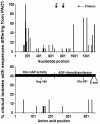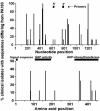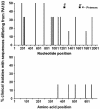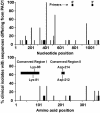Single-nucleotide-polymorphism mapping of the Pseudomonas aeruginosa type III secretion toxins for development of a diagnostic multiplex PCR system
- PMID: 12904350
- PMCID: PMC179785
- DOI: 10.1128/JCM.41.8.3526-3531.2003
Single-nucleotide-polymorphism mapping of the Pseudomonas aeruginosa type III secretion toxins for development of a diagnostic multiplex PCR system
Abstract
We mapped the coding single nucleotide polymorphisms in four toxin genes-exoS, exoT, exoU, and exoY-of the Pseudomonas aeruginosa type III secretion system among several clinical isolates. We then used this information to design a multiplex PCR assay based on the simultaneous amplification of fragments of these genes. Eight strains of known genotype were used to test our multiplex PCR method, which showed 100% sensitivity and specificity in this small sample size. This assay appears to be promising for the rapid and accurate genotyping of the presence of these genes in clinical strains of P. aeruginosa.
Figures





Similar articles
-
Development of loop-mediated isothermal amplification assays for genotyping of Type III Secretion System in Pseudomonas aeruginosa.Lett Appl Microbiol. 2015 Oct;61(4):361-6. doi: 10.1111/lam.12469. Lett Appl Microbiol. 2015. PMID: 26219625
-
Evaluation of biofilm production and characterization of genes encoding type III secretion system among Pseudomonas aeruginosa isolated from burn patients.Burns. 2012 Dec;38(8):1192-7. doi: 10.1016/j.burns.2012.07.030. Epub 2012 Sep 17. Burns. 2012. PMID: 22995427
-
Genotyping of Pseudomonas aeruginosa Type III Secretion System Using Magnetic Enrichment Multiplex Polymerase Chain Reaction and Chemiluminescence.J Biomed Nanotechnol. 2016 Apr;12(4):762-9. doi: 10.1166/jbn.2016.2222. J Biomed Nanotechnol. 2016. PMID: 27301202
-
Association between Pseudomonas aeruginosa type III secretion, antibiotic resistance, and clinical outcome: a review.Crit Care. 2014 Dec 13;18(6):668. doi: 10.1186/s13054-014-0668-9. Crit Care. 2014. PMID: 25672496 Free PMC article. Review.
-
The molecular mechanism of acute lung injury caused by Pseudomonas aeruginosa: from bacterial pathogenesis to host response.J Intensive Care. 2014 Feb 18;2(1):10. doi: 10.1186/2052-0492-2-10. eCollection 2014. J Intensive Care. 2014. PMID: 25520826 Free PMC article. Review.
Cited by
-
Population structure of Pseudomonas aeruginosa from five Mediterranean countries: evidence for frequent recombination and epidemic occurrence of CC235.PLoS One. 2011;6(10):e25617. doi: 10.1371/journal.pone.0025617. Epub 2011 Oct 3. PLoS One. 2011. PMID: 21984923 Free PMC article.
-
Comparison of Virulence-Factor-Encoding Genes and Genotype Distribution amongst Clinical Pseudomonas aeruginosa Strains.Int J Mol Sci. 2023 Jan 9;24(2):1269. doi: 10.3390/ijms24021269. Int J Mol Sci. 2023. PMID: 36674786 Free PMC article.
-
Study of Antimicrobial Resistance, Biofilm Formation, and Motility of Pseudomonas aeruginosa Derived from Urine Samples.Microorganisms. 2023 May 19;11(5):1345. doi: 10.3390/microorganisms11051345. Microorganisms. 2023. PMID: 37317319 Free PMC article.
-
Differences in antimicrobial resistance between exoU and exoS isolates of Pseudomonas aeruginosa.Eur J Clin Microbiol Infect Dis. 2025 Jul;44(7):1629-1641. doi: 10.1007/s10096-025-05132-6. Epub 2025 Apr 22. Eur J Clin Microbiol Infect Dis. 2025. PMID: 40261546 Free PMC article.
-
Chimeric bacteriocin S5-PmnH engineered by domain swapping efficiently controls Pseudomonas aeruginosa infection in murine keratitis and lung models.Sci Rep. 2022 Apr 19;12(1):5865. doi: 10.1038/s41598-022-09865-8. Sci Rep. 2022. PMID: 35440606 Free PMC article.
References
-
- Anonymous. 1996. National Nosocomial Infections Surveillance System surveillance report: data summary from October 1986 to April 1996. Am. J. Infect. Control 24:380-388. - PubMed
-
- Bodey, G., V. Bolivar, V. Fainstein, and L. Jadeja. 1983. Infections caused by Pseudomonas aeruginosa. Rev. Infect. Dis. 5:279-313. - PubMed
-
- Coburn, J., A. V. Kane, L. Feig, and D. M. Gill. 1991. Pseudomonas aeruginosa exoenzyme S requires a eukaryotic protein for ADP-ribosyltransferase activity. J. Biol. Chem. 266:6438-6446. - PubMed
Publication types
MeSH terms
Substances
Grants and funding
LinkOut - more resources
Full Text Sources
Other Literature Sources

